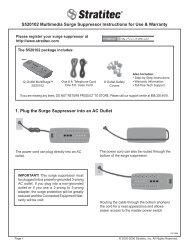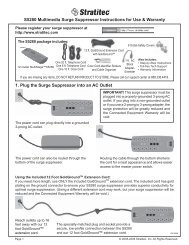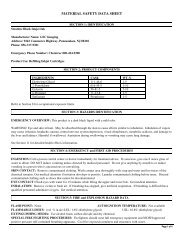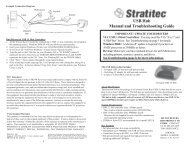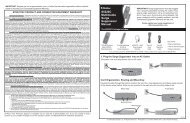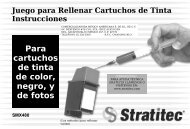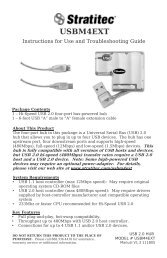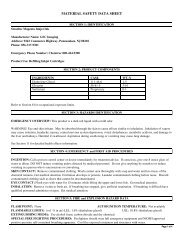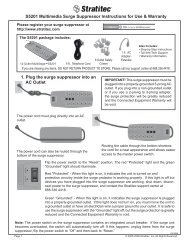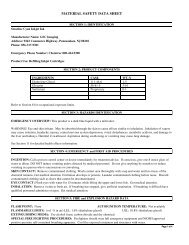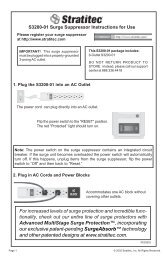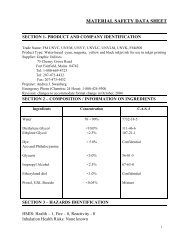MSDS Formula #2 - Stratitec
MSDS Formula #2 - Stratitec
MSDS Formula #2 - Stratitec
Create successful ePaper yourself
Turn your PDF publications into a flip-book with our unique Google optimized e-Paper software.
MATERIAL SAFETY DATA SHEET<strong>Stratitec</strong> Light Cyan Inkjet InkSECTION 1: IDENTIFICATIONManufacturer Name: GSC ImagingAddress: 9242 Commerce Highway, Pennsauken, NJ 08110Phone: 8563179301Emergency Phone Number: Chemtrec 8004249300Product Use: Refilling Inkjet CartridgesSECTION 2: PRODUCT COMPONENTSINGREDIENTS CAS#. WT.%Diethylene Glycol 111466 152Pyrrolidone 616455 15Gylcerin 56815 510nPropanol 71238 15Surfactant Proprietary 15Refer to Section 8 for occupational exposure limits.SECTION 3: HAZARDS IDENTIFICATIONEMERGENCY OVERVIEW: This product is a dark blue liquid with a mild odor.WARNING! Eye and skin irritant. May be absorbed through the skin to cause effects similar to inhalation. Inhalation of vaporsmay cause irritation, headache, nausea, central nervous system depression, visual disturbances, metabolic acidosis, and damage tothe liver and kidneys. Harmful if swallowed. Aspiration during swallowing or vomiting may cause lung damage.See Section 11 for detailed health effects information.SECTION 4: EMERGENCY and FIRST AID PROCEDURESINGESTION: Call a poison control center or doctor immediately for treatment advice. If conscious, give one 8 ounce glass ofwater to dilute. DO NOT induce vomiting unless directed by medical personnel. Do not give anything by mouth to or inducevomiting in a person who is unconscious or convulsing.SKIN CONTACT: Remove contaminated clothing. Wash contact area thoroughly with soap and water until no traces of thechemical remains. Get medical attention if irritation develops or persists. Launder contaminated clothing before reuse. Discardcontaminated clothing such as shoes that cannot be decontaminated.EYE CONTACT: Flush eyes with water for 15 minutes while lifting the upper and lower lids. Get medical attention.INHALATION: Remove victim to fresh air. If breathing has stopped, give artificial respiration. If breathing is difficult havequalified personnel administer oxygen. Get medical attention.SECTION 5: FIRE and EXPLOSION HAZARD DATAFLASH POINT: NoneAUTOIGNITION TEMPERATURE: Not availableFLAMMABLE LIMITS: (vol % in air) LEL: 1.6% (diethylene glycol)UEL: 10.8% (diethylene glycol)EXTINGUISHING MEDIA: Use alcohol foam, carbon dioxide and dry chemical.SPECIAL FIRE FIGHTING PROCEDURES: Firefighters should wear full emergency equipment and NIOSH approvedpositive pressure selfcontained breathing apparatus. Cool fire exposed containers and structures with water.Page 1 of 4
UNUSUAL FIRE AND EXPLOSION HAZARDS: None known.HAZARDOUS COMBUSTION PRODUCTS: Carbon monoxide, carbon dioxide, nitrogen oxides and acrolein.SECTION 6: ACCIDENTAL RELEASE MEASURESSTEPS TO BE TAKEN IN CASE MATERIAL IS RELEASED OR SPILLED: Wear appropriate protective clothing asdescribed in Section 8. Dike spill and absorb with an inert material. Collect into closable containers for proper disposal. .Report spill as required by local and federal regulations.SECTION 7: HANDLING and STORAGEPRECAUTIONS TO BE TAKEN IN HANDLING AND STORING: Protect containers from physical damage. Store in acool, dry area away from oxidizers and other incompatible materials.Avoid contact with eyes, skin and clothing. Avoid breathing vapors. Use with adequate ventilation. Remove and laundercontaminated clothing before reuse. Wash thoroughly after handling and before eating, drinking, smoking or using toiletfacilities.OTHER PRECAUTIONS: Empty containers retain product residues and are hazardous. Follow all <strong>MSDS</strong> precautions inhandling empty containers.SECTION 8: EXPOSURE CONTROLS and PERSONAL PROTECTIONINGREDIENTS CAS#. EXPOSURE LIMITSDiethylene Glycol 111466 10 mg/m 3 TWA AIHA WEEL2Pyrrolidone 616455 None EstablishedGlycerin 56815 5 mg/m 3 TWA OSHA PEL (respirable fraction10 mg/m 3 TWA ACGIH TLVnPropanol 71238 200 ppm TWA OSHA PEL200 ppm TWA ACGIH TLV400 ppm STEL ACGIHSurfactant Proprietary None EstablishedVENTILATION: Provide adequate general or local exhaust ventilation to maintain vapor concentrations below the exposurelimits.RESPIRATORY PROTECTION: Use NIOSH approved respirator with organic vapor cartridges or supplied air respirator ifneeded. Selection of respiratory protection depends on the contaminant type, form and concentration. Select in accordance withOSHA 1910.134 and good Industrial Hygiene practice.EYE PROTECTION: Chemical safety goggles if splashing is possible.PROTECTIVE CLOTHING: Butyl rubber or other impervious gloves are recommended if contact is likely. Impervious apron,boots and other clothing are recommended if needed to prevent contact or if splashing is possible.OTHER PROTECTIVE EQUIPMENT: For operations where contact can occur, an eye wash facility should be immediatelyavailable.SECTION 9: PHYSICAL and CHEMICAL PROPERTIESBOILING POINT (@760 mmHg): 215 o F / 101 o CFREEZING POINT: Not availableSPECIFIC GRAVITY (H20=1): 1.021.04COEFFICIENT of WATER/OIL: Not availableVAPOR PRESSURE: 17.5 mmHgEVAPORATION RATE: < Butyl AcetateVAPOR DENSITY (Air=1): Heavier than air pH: 6.08.0SOLUBILITY IN WATER: CompletePage 2 of 4
APPEARANCE AND ODOR: Dark red liquid with a mild odor.SECTION 10: STABILITY and REACTIVITYSTABILITY: Stable.CONDITIONS TO AVOID: None known.INCOMPATIBILITY: Strong oxidizing agents, strong acids and strong bases.HAZARDOUS DECOMPOSITION PRODUCTS: Thermal decomposition may yield carbon monoxide, carbon dioxide,nitrogen oxides and acrolein.HAZARDOUS POLYMERIZATION: Will not occur.SECTION 11: TOXICOLOGICAL INFORMATIONEYE CONTACT: May cause irritation with redness and pain.SKIN CONTACT: Contact may cause skin irritation with redness, swelling and cracking. Widespread contact may causeabsorption with symptoms similar to inhalation.INHALATION: Vapors or mists may cause respiratory irritation with headache, dizziness, nausea, drowsiness, incoordination,euphoria, visual disturbances, fatigue, respiratory arrest and unconsciousness. May cause damage to the kidneys and liver.INGESTION: Swallowing may cause gastrointestinal irritation, nausea, vomiting, diarrhea, increased respiration, increasedheart rate decreased urine output, severe metabolic acidosis and damage to the kidneys and liver. Aspiration into the lungs duringswallowing or vomiting may cause lung damage.CHRONIC EFFECTS of OVEREXPOSURE: Prolonged or repeated exposure may cause dermatitis. Diethylene glycol hasbeen found to be positive in the Ames Assay for mutagenicity. 2pyrrolidione was found to cause birth defects in studies withlaboratory animals.CARCINOGENICITY: None of the components of this products are listed as a carcinogen by NTP, IARC or OSHA.MEDICAL CONDITIONS AGGRAVATED BY EXPOSURE: Individuals with chronic skin, respiratory, kidney and liverdisorders may be at increased risk from exposure to this material.TOXICOLOGY DATA: Toxicity values for this chemical are:Diethylene Glycol:2Pyrrolidone:Glycerin:nPropanol:Surfactant:Oral rat LD 50 : 12,565 mg/kgSkin rabbit LD 50 : 11,890 mg/kgOral rat LD 50 : 328 mg/kgOral rat LD 50 : 12,600 mg/kgSkin rabbit LD 50 : >10 gm/kgInhalation rat LC 50 : >570 mg/m3/1 hourOral rat LD 50 : 1,870 mg/kgSkin rabbit LD 50 : 11,890 mg/kgNo data availableSECTION 12: ECOLOGICAL INFORMATIONDiethylene Glycol:2Pyrrolidone:Glycerin:nPropanol:Surfactant:No data availableEC 50 /48 hour daphnia magna >500 mg/lLC 50 /48 hour golden orfe >500 mg/lNo data availableLC 50 /96 hour fathead minnow >1000 ul/lLC 50 /96 hour daphnia magna >1000 ul/lLC 50 /24 hour daphnia magna 3.25.2 mg/lPage 3 of 4
LC 50 /96 hour fathead minnow 3.2 mg/lSECTION 13: DISPOSAL INFORMATIONWASTE DISPOSAL METHOD: Dispose of in accordance with all local, state and federal regulations.DOMESTIC TRANSPORTATIONSECTION 14: TRANSPORTATION INFORMATIONDOT SHIPPING NAME: Not RegulatedDOT HAZARD CLASSIFICATION: Not RegulatedDOT LABELS REQUIRED (49CFR172.101): Not ApplicableUN NUMBER: NoneINTERNATIONAL TRANSPORTATIONIMDG SHIPPING NAME: Not RegulatedIMDG CLASS: Not RegulatedUN NUMBER: Not ApplicableIMDG LABEL: NoneSECTION 15: REGULATORY INFORMATIONOSHA HAZARD CLASSIFICATION: Irritant, target organ effectsEPA SARA 311 HAZARD CLASSIFICATION: Acute health, chronic healthSARA TITLE 111 SECTION 313 INFORMATION: This product contains the following chemicals that are regulated underSARA 313: NoneCERCLA HAZARDOUS SUBSTANCE (40CFR 116): Not applicableREPORTABLE QUANTITY: Not applicableSTATE RTK COMPOSITION INFORMATIONCOMPONENT CAS # WT% PA MADiethylene Glycol 111466 15 Y N2Pyrrolidone 616455 15 Y YGlycerin 56815 510 Y YnPropanol 71238 15 Y YCALIFORNIA PROPOSITION 65 INFORMATION: This product contains no California Proposition 65 regulatedchemicals.WHMIS CLASSIFICATION: Class D Division 2 Subdivision B (Toxic material causing other chronic effects)SECTION 16: OTHER INFORMATIONNFPA Rating: Health = 1 Fire = 0 Reactivity = 0HMIS Rating: Health = 1 Fire = 0 Reactivity = 1Page 4 of 4



